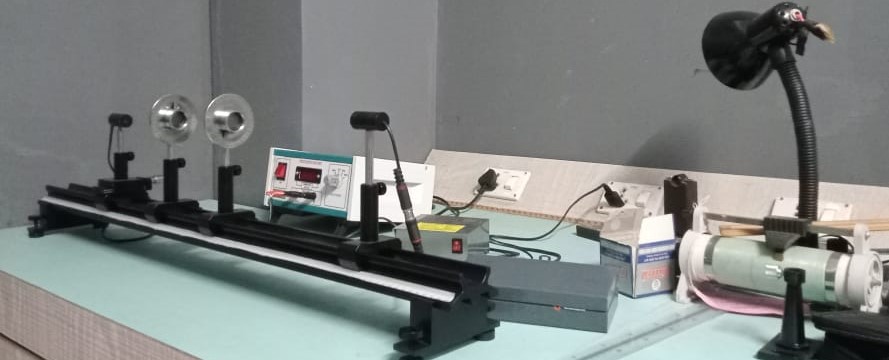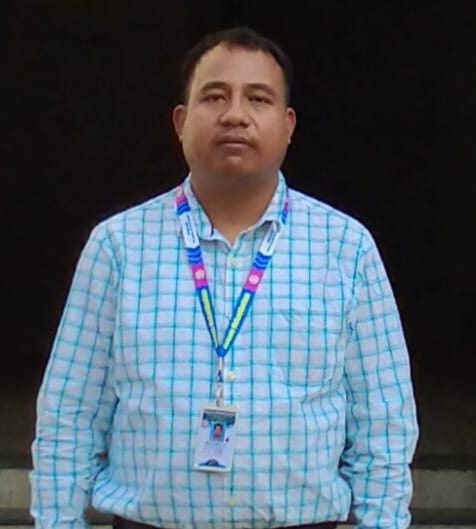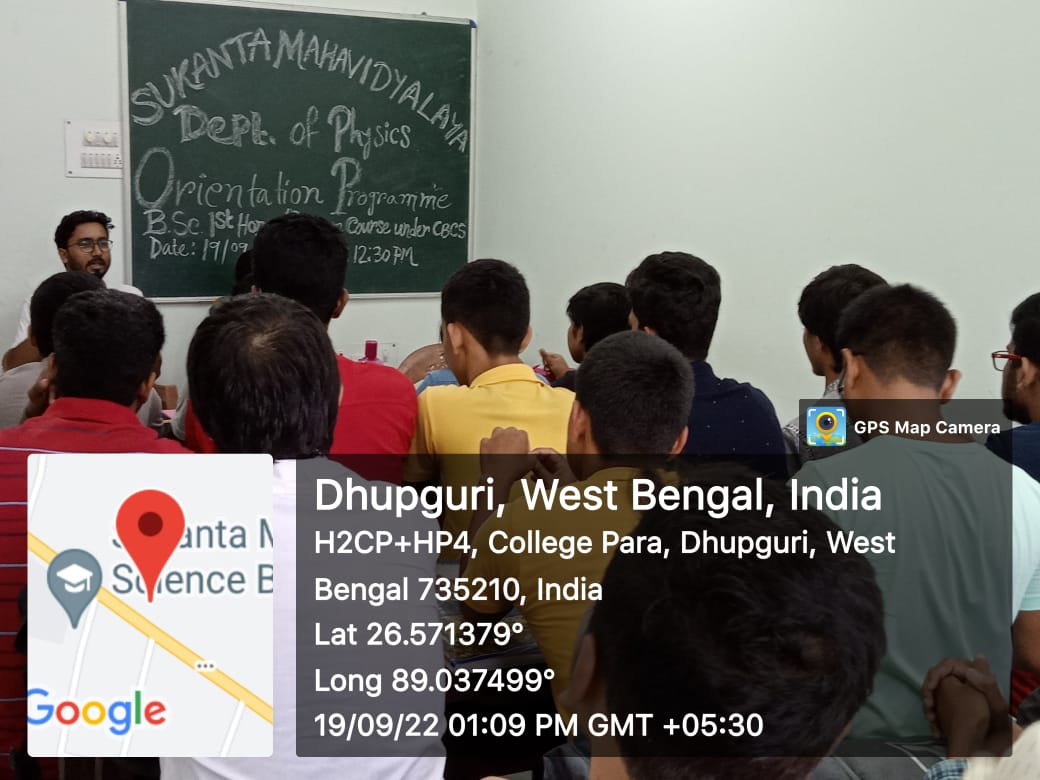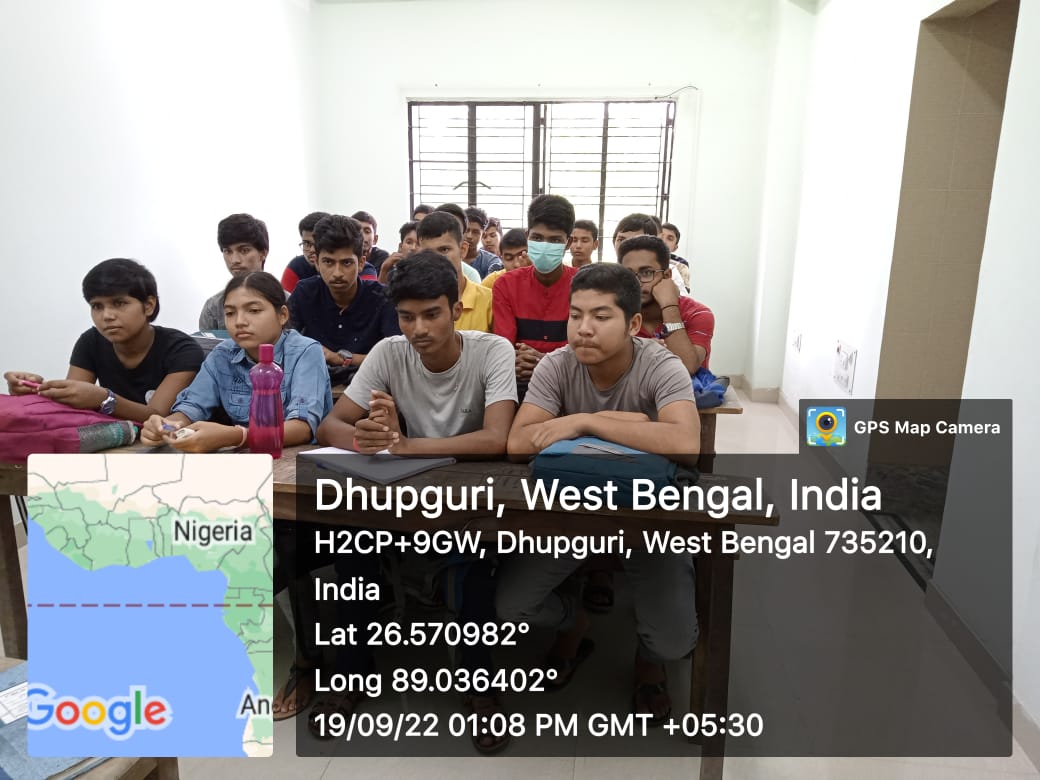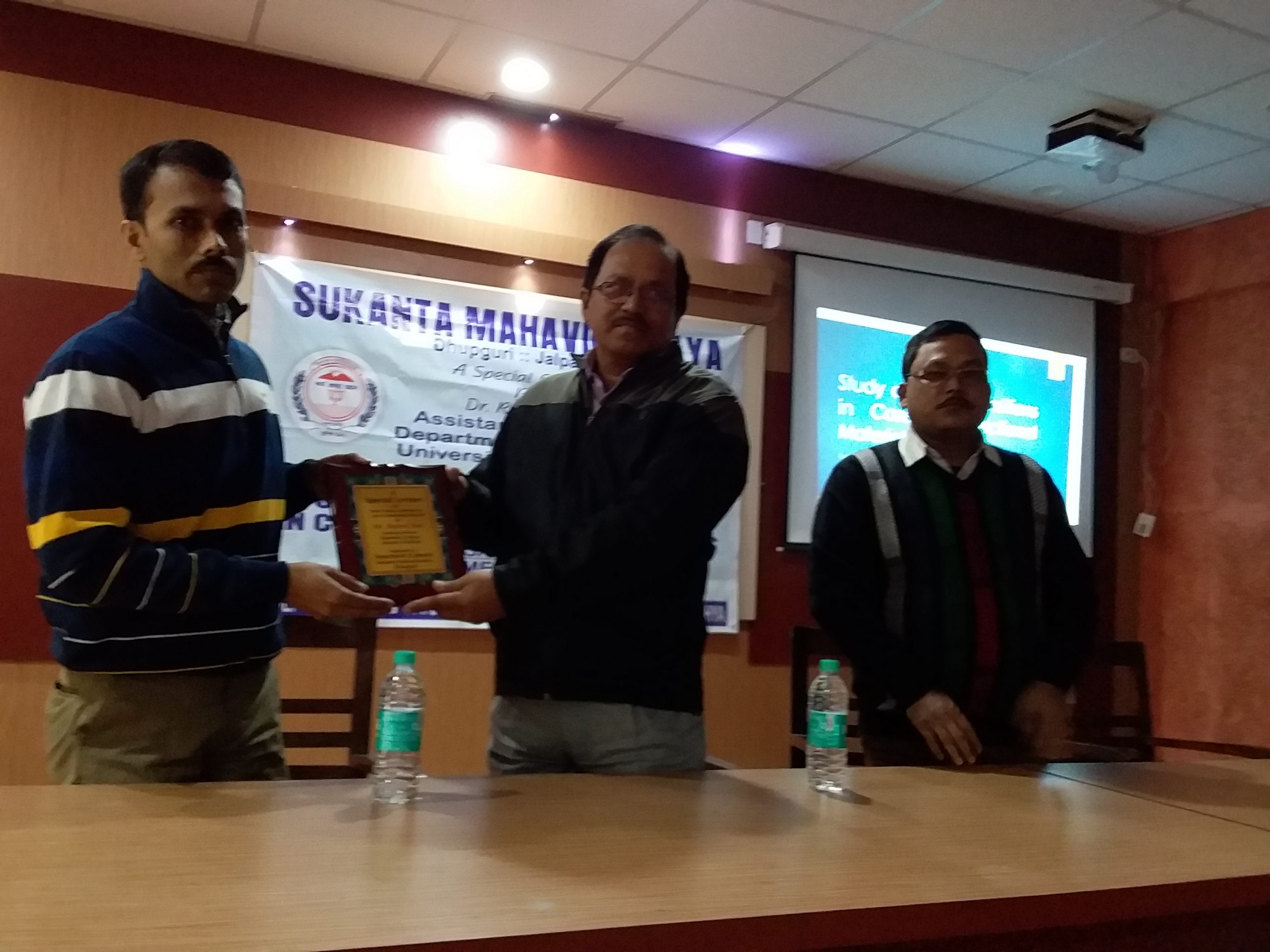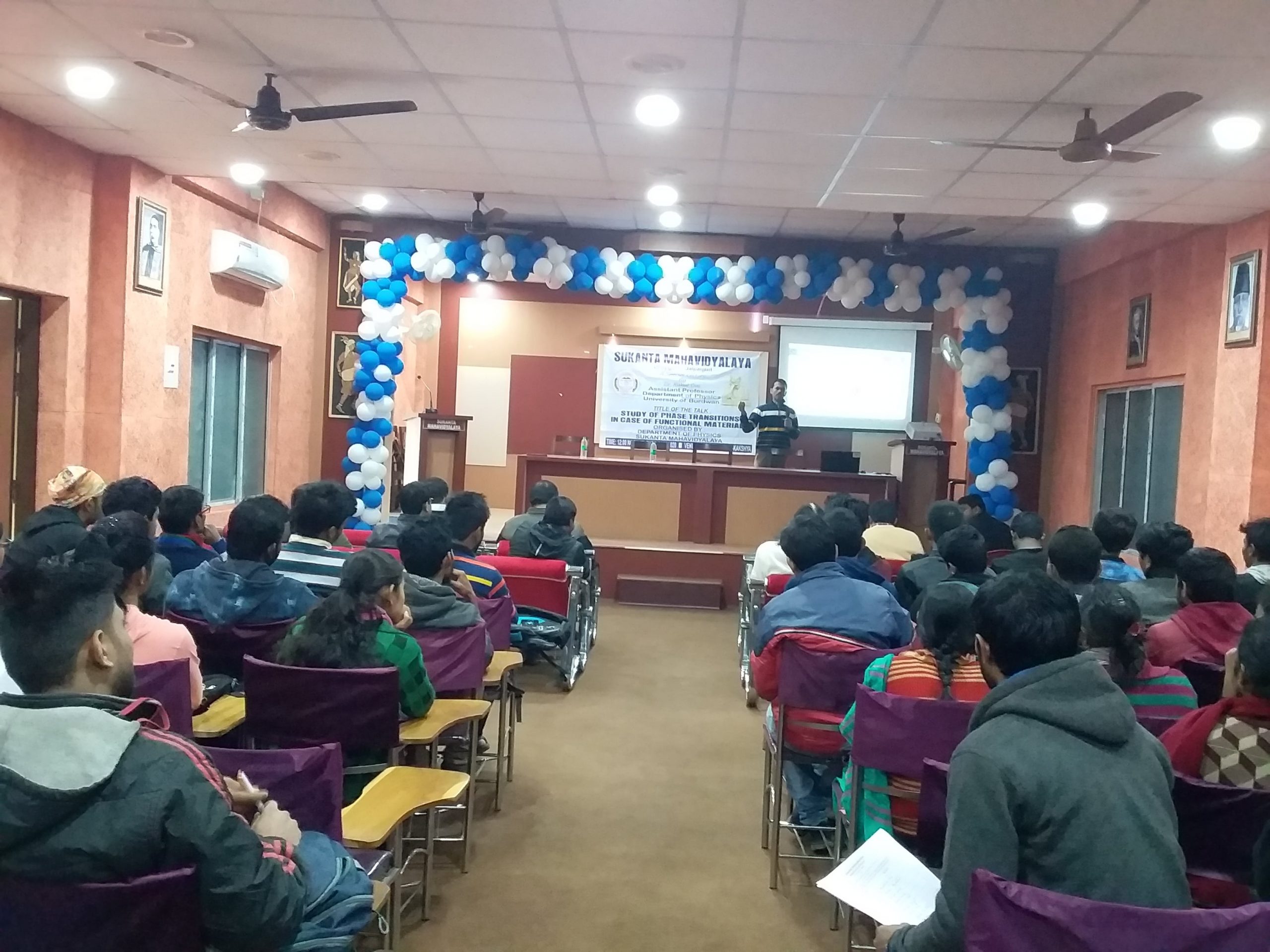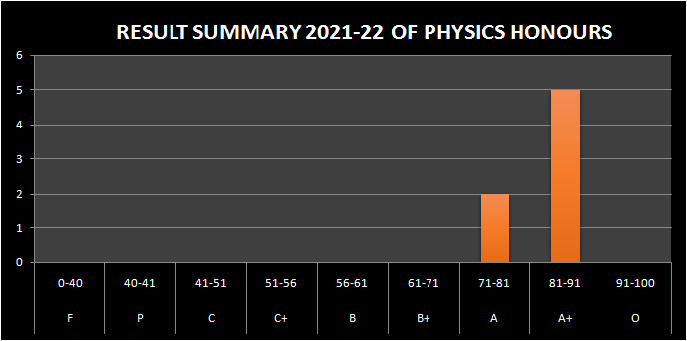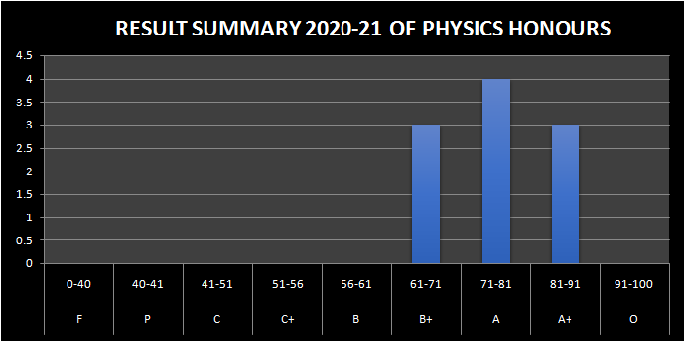CBCS System (Honours and Programme)
SEEMESTER-I
CC1: Mathematical Physics-I
- Basic understanding in areas like (i) Limits (ii) Continuity (iii) Differentiation (iv) Plotting of functions etc.
- Knowledge gain in areas like (i) Vector Calculus (ii) Curvilinear coordinate systems (iii) Dirac-Delta function
- It includes introduction to probability
- Knowledge gain in (i) Computer organization (ii) Basic scientific computing (iii) Plotting graphs with Gnuplot (iv)Programming using Python etc.
CC2: Mechanics
- Knowledge gain in Fundamentals of Dynamics such as frame of references, Newton’s law of motion, motion of projectile, rocket etc.
- Knowledge gain in areas in (i) Work and energy (ii) Collisions (iii) Rotational Dynamics (iv) Elasticity (v) Fluid Motion (vi) Gravitation and Central Force Motion (vii) Oscillations (viii) Non-Inertial Systems etc.
- Introduction to Special Theory of Relativity
- Knowledge gain in performing experiment to determine spring constant, acceleration due to gravity, MI of fly wheel, viscosity of water, rigidity modulus etc.
GE1: Mechanics
- Knowledge gain in vectors, ordinary differential equations
- Understanding of Newton’s law of motion
- Knowledge gain in areas in (i) Momentum and energy (ii) Collisions (iii) Rotational Dynamics (iv) Elasticity (v) Gravitation (vi) Oscillations etc.
- Introduction to Special Theory of Relativity
- Knowledge gain in performing experiment to determine spring constant, acceleration due to gravity, MI of fly wheel, viscosity of water, rigidity modulus etc.
DSC1: Mechanics
- Knowledge gain in vectors, ordinary differential equations
- Understanding of Newton’s law of motion
- Knowledge gain in areas in (i) Momentum and energy (ii) Collisions (iii) Rotational Dynamics (iv) Elasticity (v) Gravitation (vi) Oscillations etc.
- Introduction to Special Theory of Relativity
- Knowledge gain in performing experiment to determine spring constant, acceleration due to gravity, MI of fly wheel, viscosity of water, rigidity modulus etc.
SEEMESTER-II
CC3: Electricity and Magnetism
- Develop ideas about electric field, magnetic field and electric potential.
- Basic understanding of dielectric properties of matter.
- Knowledge gain in magnetics properties of matter, electromagnetic induction, electrical circuits, network analysis etc.
- Handling of electrical instruments such as multimeter, capacitor, CRO, resistance, inductor etc.
- Performing experiments to understand RC circuit, LCR circuit, Anderson’s bridge etc.
CC4: Waves and Optics
- Knowledge gain in areas like (i) Harmonic Oscillations (ii) Wave Motion (iii) Velocity of waves (iv) Superposition of Harmonic Waves
- Develop ideas about Wave Optics, Holography
- Knowledge gain in areas like (i) Interference (ii) Diffraction
- Knowledge gain in handling optical instruments like (i) Prism (ii) Grating (iii) Spherometer (iv) Travelling Microscope etc.
- Perform experiments to studyLissajous Figures
- Perform experiments to determine various quantity like (i)angle of prism (ii) refractive index of the Material of a prism (iii) wavelength of sodium source (iv) dispersive power and resolving power of a plane diffraction grating.
GE2: Electricity and Magnetism
- Basic understanding of vector analysis which includes (i) Review of vector algebra (Scalar and Vector product), (ii)gradient, (iii) divergence, (iv) Curl, (v) Vector Integration, (vi) Gauss-divergence theorem (vii) Stoke's theorem of vectors
- Develop ideas about electric field, magnetic field and electric potential.
- Knowledge gain in electromagnetic induction
- Knowledge gain in Maxwell`s equations and Electromagnetic wave propagation
- Handling of electrical instruments such as multimeter, capacitor, CRO, resistance, inductor etc.
- Performing experiments to understand RC circuit, LCR circuit, Carey Foster’s Bridge
DSC2: Electricity and Magnetism
- Basic understanding of vector analysis which includes (i) Review of vector algebra (Scalar and Vector product), (ii)gradient, (iii) divergence, (iv) Curl, (v) Vector Integration, (vi) Gauss-divergence theorem (vii) Stoke's theorem of vectors
- Develop ideas about electric field, magnetic field and electric potential.
- Knowledge gain in electromagnetic induction
- Knowledge gain in Maxwell`s equations and Electromagnetic wave propagation
- Handling of electrical instruments such as multimeter, capacitor, CRO, resistance, inductor etc.
- Performing experiments to understand RC circuit, LCR circuit, Carey Foster’s Bridge
SEEMESTER-III
CC5: Mathematical Physics-II
- Knowledge gain in areas (i) Fourier Series (ii) Frobenius Method and Special Functions (iii) Beta and Gamma Functions (iv) Variational calculus in physics (v) Partial Differential Equations and applications
- Introduction to the Numerical computation using numpy and scipy
- Knowledge gain in Curve fitting, Least square fit, Goodness of fit, standard deviation
- Solution of Linear system of equations by Gauss elimination method and Gauss Seidal method. Diagonalization of matrices, Inverse of a matrix, Eigen vectors, eigen values problems are learned
- Solution of ODE First Order Differential equation Euler, modified Euler and Runge-Kutta second order methods Second order differential equation Fixed difference method using python are learned.
CC6: Thermal Physics
- Knowledge gain in Zeroth and First Law of Thermodynamics, Second Law of Thermodynamics, Entropy
- Thermodynamic Potentials, Maxwell’s Thermodynamic Relations, Kinetic Theory of Gases are learned
- Performing experiments to determine (i) Mechanical Equivalent of Heat (ii) Planck’s constant using black body radiation (iii) the coefficient of thermal conductivity (iv) the coefficient of thermal conductivity of a bad conductor (v) the temperature co-efficient of resistance by Platinum resistance thermometer
- Study of the variation of thermos-emf across two junctions of a thermocouple with temperature.
CC7: Digital Systems and Applications
- Integrated Circuits, Digital Circuits, Boolean algebra, Data processing circuits are learned
- Knowledge gain in Timers, Shift registers, Counters, Computer Organization
- Test of a Diode and Transistor using a Multimeter is learned
- Conversion of Boolean expression into logic circuit and design it using logic gate ICs is learned
- Verify and design AND, OR, NOT and XOR gates using NAND gates is learned
- Half Adder, Full Adder and 4-bit binary Adder is learned
GE: Mechanics
- Knowledge gain in vectors, ordinary differential equations
- Understanding of Newton’s law of motion
- Knowledge gain in areas in (i) Momentum and energy (ii) Collisions (iii) Rotational Dynamics (iv) Elasticity (v) Gravitation (vi) Oscillations etc.
- Introduction to Special Theory of Relativity
- Knowledge gain in performing experiment to determine spring constant, acceleration due to gravity, MI of fly wheel, viscosity of water, rigidity modulus etc.
DSC3: THERMAL PHYSICS AND STATISTICAL MECHANICS
- Knowledge gain in areas: (i) Thermodynamic Description of system (ii) Thermodynamic Potentials (iii) Kinetic Theory of Gases (iv) Theory of Radiation (v) Statistical Mechanics
- Performing experiments to determine (i) Mechanical Equivalent of Heat (ii) Planck’s constant using black body radiation (iii) the coefficient of thermal conductivity (iv) the coefficient of thermal conductivity of a bad conductor (v) the temperature co-efficient of resistance by Platinum resistance thermometer
- Study of the variation of thermos-emf across two junctions of a thermocouple with temperature
SEC1: Electrical Circuits and Networks
- Knowledge gain in areas (i) Basic Electricity Principles (ii) Understanding Electrical Circuits (iii) Electrical Drawing and Symbols (iv) Generators and Transformers (v) Electric Motors (vi) Solid-State Devices (vii) Electrical Protection (viii) Electrical Wiring.
SEEMESTER-IV
CC8: Mathematical Physics-III
- Knowledge gain in areas of complex analysis like (i) Complex Numbers and their Graphical Representation (ii) Functions of Complex Variables (iii) analytic functions (iv) Singular functions etc.
- Concepts in matrices, Eigen-values and Eigenvectors problems
- Knowledge gain in Fourier Transform to solve one dimensional (i) Wave equation (ii) Diffusion/Heat Flow Equation
- Knowledge gain in python programing to compute (i) Differential equations (ii) Dirac-Delta function (iii) Fourier series (iv) Complex roots etc.
CC9: Elements of Modern Physics
- Knowledge gain in areas like (i) black body Radiation (ii) Photo-electric effect (iii) Compton scattering (iv) Wave description of particles (v) Group and Phase velocities
- Knowledge gain in (i) Two slit interference experiment with photons (ii) Schrodinger equation (iii) wave function (iv) probability current densities
- Knowledge gain in (i) Atomic and nuclear physics (ii) Radioactivity (iii) Fission and fusion (iv) Lasers
- Perform experiments to determine Planck’s constant, work function of material, wavelength of H-alpha emission line, ionization potential of mercury, tunneling effect in tunnel diode, the wavelength of laser source etc.
CC10: Analog Systems and Applications
- Knowledge gain in areas like (i) Semiconductor Diodes (ii) Two-terminal Devices and their Applications (iii) Bipolar Junction transistors (iv) Field Effect transistors (v) Amplifiers
- Knowledge gain in handling experiments to study (i) V-I characteristics of PN junction diode, (ii) he V-I characteristics of a Zener diode and its use as voltage regulator (iii) V-I and power curves of solar cells (iv) CE transistor amplifier (v) Op-amp
DSC4: Waves and Optics
- Knowledge gain in areas like (i) Harmonic Oscillations (ii) Wave Motion (iii) Velocity of waves (iv) Superposition of Harmonic Waves (v) Fluids
- Develop ideas about Wave Optics
- Knowledge gain in areas like (i) Interference (ii) Diffraction (iii) Polarization (iv) Michelson’s Interferometer
- Knowledge gain in handling optical instruments like (i) Prism (ii) Grating (iii) Spherometer (iv) Travelling Microscope etc.
- Perform experiments to study Lissajous Figures
- Perform experiments to determine various quantity like (i) angle of prism (ii) refractive index of the Material of a prism (iii) wavelength of sodium source (iv) dispersive power and resolving power of a plane diffraction grating
SEC2: RENEWABLE ENERGY AND ENERGY HARVESTING
- Knowledge gain about Fossil fuels and Alternate Sources of energy.
- Understanding the energy crisis.
- Understanding importance of renewable energy.
- Knowledge gain about Solar energy and its usefulness.
- Knowledge gain about Wind Energy harvesting and its usefulness.
- Knowledge gain about Ocean Energy.
- Knowledge gain about Geothermal Energy and Hydro Energy.
- Knowledge gain about Piezoelectric Energy harvesting.
- Knowledge gain about Electromagnetic Energy Harvesting
GE2: Electricity and Magnetism
- Basic understanding of vector analysis which includes (i) Review of vector algebra (Scalar and Vector product), (ii)gradient, (iii) divergence, (iv) Curl, (v) Vector Integration, (vi) Gauss-divergence theorem (vii) Stoke's theorem of vectors
- Develop ideas about electric field, magnetic field and electric potential.
- Knowledge gain in electromagnetic induction
- Knowledge gain in Maxwell`s equations and Electromagnetic wave propagation
- Handling of electrical instruments such as multimeter, capacitor, CRO, resistance, inductor etc.
- Performing experiments to understand RC circuit, LCR circuit, Carey Foster’s Bridge
SEEMESTER-V
CC11: Quantum Mechanics
Knowledge gained on
- General formalism of Quantum Mechanics, mixed states, wave packets, uncertainty relation, representation in quantum mechanics, picture of quantum mechanics, Eigen value problem, matrix mechanics, angular momentum, Zeeman effect, stark effect,
- Schrodinger equation, turning points and connection formulae, bound states solution, barrier penetration.
- Basic knowledge of Quantum Mechanics is acquired.
- Skills and techniques to use Quantum mechanical principles in simple and complicated systems.
- The basic knowledge to solve 1 dimensional and thereafter 3-dimensional potential problems.
- The students after the course are competent enough to use the knowledge of Quantum Mechanics to different Quantum Mechanical systems encountered in different areas of Physics.
- They learn to solve the non-relativistic quantum mechanical problem and can demarcate the problems which are quantum mechanical
CC12: Solid State Physics
Knowledge gained on
- Elementary Crystallography, basis, crystal class and Ewald construction.
- Knowledge gained on lattice vibrations and thermal properties and quantization of lattice vibrations, phonon momentum.
- Discussion on free electron Fermi gas with Classical free electron theory and Fermi-Dirac probability distribution function is discussed and hence a comprehensive view on Fermi energy is obtained.
- Understanding the Dielectric Properties of insulators and ferro-electricity.
- Knowledge gained and Understanding the Magnetic properties of solids, Diamagnetism, paramagnetic susceptibility and ferromagnetism is discussed and a quantum picture of Heisenberg exchange energy is covered.
- Knowledge gained on Semiconductors and their properties include motion of hole-electron pair-carrier transport equation.
- Understanding Superconductivity: Properties of superconductors with discussion on Meissner effect. London's equations are covered and discussion on superconducting magnets is carried out.
- Skills gained in crystallography, knowledge on symmetry operations and classification of lattices gives an understanding to define the structure of a crystal.
- Acquired knowledge on band theory of solid.
DSE1: Advanced Mathematical Physics I
- Knowledge gained in areas like (i) Laplace (ii)Linear Vector Spaces (iii) Cartesian Tensors and (iv) General Tensors.
- The students acquire skills to apply different mathematical techniques to solve problems in the areas of heat flow, potential theory, elasticity, fluid mechanics, electromagnetic theory and quantum mechanics and condensed matter physics.
- The students acquire skills to apply different mathematical techniques to a very wide range of natural systems from very simple (like an atom) to very complicated (like an astrophysical object), and try to understand the underlying dynamics of each. Most of these techniques are useful in other scientific and/or technology areas too.
- Students gain competence which will enable them to solve problems in many areas of science and engineering. Students are/should be competent enough to solve problems and apply the above-mentioned techniques in areas like Quantum Mechanics, Quantum Field Theory, Astrophysics and Cosmology. They should be able to apply the mathematical techniques even beyond in Chemical, Biological and Geological systems as well as in technology.
DSE2: Atmospheric Physics
- Understanding the importance different layer of atmosphere.
- Understanding the Atmospheric Dynamics.
- Understanding the principle of Atmospheric Radar and Lidar.
- Understanding the usefulness of Atmospheric Radar and Lidar
- Understanding the Atmospheric Aerosols.
- Understanding about pollution.
DSE1 (P): Elements of Modern Physics
- Knowledge gain about photo-electric effect, Compton scattering, matter waves, uncertianty principle, schrodinger equation, radioactivity, nuclear model and laser.
- Acquired knowledge about quantum nature of light, wave particle dual nature of light.
- Understanding the uncertainty principle,
- Understanding the different nuclear reactions and their importance
SEC1: Electrical Circuits and Networks
- Knowledge gained on (i) Basic Electricity Principles, (ii)Electrical Circuits(iii)Electrical Drawing and Symbols (iv)Generators and Transformers Electric Motor Solid-State Devices and (V)Electrical Protection &Electrical Wiring.
- Understanding Electrical Circuits & Electrical Drawing and Symbols.
- Understanding the working principle electrical motors and generators.
- Understanding the working principle Electrical Protection &Electrical Wiring and importance electrical protection.
SEEMESTER-VI
CC13: Electromagnetic Theory
- Knowledge gain about Maxwell’s equations; Gauge transformations Electromagnetic energy, energy density.
- Develop ideas about EM wave propagation and polarization.
- Basic understanding about wave guides.
- Apart from their basic understanding of the subject, the students are efficient enough to solve various unknown problems of electromagnetic theory relevant for competitive examinations
CC14: Statistical Mechanics
Knowledge gained about
- Basic postulates of classical statistical mechanics;
- concepts of microstates, phase-space, partition function and density function; micro-canonical, canonical and grand canonical ensembles;
- Maxwell-Boltzmann distribution; connection between statistical mechanics and thermodynamics applications to simple systems.
- Quantum statistics; density operator, indistinguishable particles;
- Fermi-Dirac and Bose-Einstein distributions; applications -Degenerate Fermi gas, White dwarf system, Saha’s ionization formula,
- Black-body radiation, Debye’s theory of specific heat, Pauli’s theory of paramagnetism, Bose-Einstein condensation.
- Introductory knowledge of Statistical Mechanics is acquired. Skills of using the statistical principles and applying the techniques learnt thereof to simple thermodynamic systems under equilibrium are developed.
- Students are/should be competent enough to connect the principles of statistics with the laws of mechanics, and apply their knowledge to more complicated thermodynamic systems in and beyond the domains of physics (like in chemical, biological, geological systems and in technology), as well as to systems that are not in equilibrium.
DSE3: Advanced Mathematical Physics-II
Knowledge gained in areas like
- Calculus of Variations- Variational principle, Euler-Lagrange Equations of motion, canonical pair of variables, Poisson Brackets.
- Knowledge gained and understanding the group theory
- Knowledge gained and understanding the advanced probability theory.
- The students acquire skills to apply different mathematical techniques to solve problems in the areas of heat flow, potential theory, elasticity, fluid mechanics, electromagnetic theory and quantum mechanics and condensed matter physics.
- The students acquire skills to apply different mathematical techniques to a very wide range of natural systems from very simple (like an atom) to very complicated (like an astrophysical object), and try to understand the underlying dynamics of each.
- Most of these techniques are useful in other scientific and/or technology areas too.
- Students gain competence which will enable them to solve problems in many areas of science and engineering.
- Students are/should be competent enough to solve problems and apply the above-mentioned techniques in areas like Quantum Mechanics, solid state of physics
- They should be able to apply the mathematical techniques even beyond in Chemical, Biological and Geological systems as well as in technology.
DSE4: Nuclear and Particle Physics
Knowledge gained in
- Nuclear physics general properties of nuclei, nuclear models.
- The different nuclear interactions and the corresponding nuclear potentials and its dependence on the couplings are learned.
- Understanding nuclear reactions, interaction of nuclear radiation with matter.
- Knowledge acquired detector for nuclear radiations and particle accelerators
- Knowledge gained in particle physics.
- The knowledge helps to choose for an Advance course in Nuclear and particle Physics.
- Understanding of the nucleus at low energy.
- Develop basics ideas to solve some of the problems of nuclear physics and their limitations in nature.
DSE1 (P): Solid State Physics
Knowledge gained on
- Elementary Crystallography, basis, crystal class and Ewald construction.
- Knowledge gained on lattice vibrations and thermal properties and quantization of lattice vibrations, phonon momentum.
- Discussion on free electron Fermi gas with Classical free electron theory and Fermi-Dirac probability distribution function is discussed and hence a comprehensive view on Fermi energy is obtained.
- Understanding the Dielectric Properties of insulators and ferro-electricity.
- Knowledge gained and Understanding the Magnetic properties of solids, Diamagnetism, paramagnetic susceptibility and ferromagnetism is discussed and a quantum picture of Heisenberg exchange energy is covered.
- Knowledge gained on Semiconductors and their properties include motion of hole-electron pair-carrier transport equation.
- Understanding Superconductivity: Properties of superconductors with discussion on Meissner effect. London's equations are covered and discussion on superconducting magnets is carried out.
- Skills gained in crystallography, knowledge on symmetry operations and classification of lattices gives an understanding to define the structure of a crystal.
- Acquired knowledge on band theory of solid.
SEC2 (P): RENEWABLE ENERGY AND ENERGY HARVESTING
- Knowledge gain about Fossil fuels and Alternate Sources of energy.
- Understanding the energy crisis.
- Understanding importance of renewable energy.
- Knowledge gain about Solar energy and its usefulness.
- Knowledge gain about Wind Energy harvesting and its usefulness.
- Knowledge gain about Ocean Energy.
- Knowledge gain about Geothermal Energy and Hydro Energy.
- Knowledge gain about Piezoelectric Energy harvesting.
- Knowledge gain about Electromagnetic Energy Harvesting
Course Outcome (Honours and General)
(1+1+1) System
Part-I
Paper-I
Mathematical Physics
- Application of vector calculus in various physical problems
- Knowledge of orthogonal curvilinear coordinate system
- Knowledge about the expansion of a function in a Fourier series and its application in mathematical problems relevant to the physical sciences
- Concepts of matrix and its application in various physical problems.
- Concept and technique to solve ordinary second order differential equations
- Knowledge of solving physically relevant partial differential equations using standard methods like separation of variables
- Gain Knowledge about some special functions related to physics.
- Concepts of probability and statistics and their uses.
Classical Mechanics-I
- Learnt to express velocity and acceleration in different co-ordinate systems
- Review of Newton’s laws of motion and solving problems
- Knowledge of mechanics of system of particles
- Grow concept about the pseudo forces appearing in non-inertial frame of references
- Knowledge the rigid body dynamics
- Concept of central force and its applications
- Grow concept about Newton’s laws of gravitation and determination of gravitational potential and intensities in various cases.
General Properties of Matter
- Knowledge of strain, stress, Hooke’s law and various elastic constants and their relations
- Concept of bending moment and cantilever
- Knowledge gain about origin of surface tension and its applications in various physical phenomena
- Review of streamline and turbulent flow and the property of viscosity
- Concept of the capillary flow of low-viscous fluid and Poiseulle’s equation
- Knowledge terminal velocity of a body falling through viscous medium and Stoke’s law
- Idea to determination of the co-efficient of viscosity.
Paper-II
Heat
- Concept of pressure of gas in terms of kinetic theory
- Concept to relate pressure of the gas to the average speed, r.m.s speed, most probable speed of the gas molecules
- Knowledge gain about various distribution laws of gases (velocity, momentum and energy)
- Concept about the significance of mean free path and survival equation
- Ability to understand the transport phenomena (heat, momentum and energy)
- Knowledge gain about the experimental evidences of deviation from ideal gas laws
- Knowledge of critical temperature, pressure and volume.
- Knowledge about the basic laws of heat transfer
- Knowledge to analyze problems involving of steady state heat conduction in simple geometries.
- Idea about radiation of heat, the Stefan- Boltzmann radiation law of energy radiation.
Sound
- Gain concepts about acoustics.
- Basic understanding of characteristics of SHM
- Knowledge to solve the differential equation of SHM
- Knowledge gain about Lissajous figures
- Learnt to solve the wave equation and understand significance of transverse waves, vibration of stretched string.
- Learnt to solve wave equation of a longitudinal vibration in elastic medium
- Learn about the Reverberation and Building acoustics.
- Concept gain about the Doppler effect.
Electricity-I
- Develop ideas about electric field and electric potential.
- Learnt Coulomb’s law in electrostatic
- Apply Gauss’ Law to compute electric field due to symmetric charge distribution
- Knowledge gain to solve Laplace’s equation in electrostatics
- Concept of electric dipoles and its interaction with external electric field.
- Understanding of electrostatics in linear dielectric medium.
- Idea to use of method of images to determine the electric potential and field
- Concept about energy stored in a capacitor
- Knowledge to apply Kirchhoff's voltage law and current law in various electrical circuits
- Acquire knowledge about working principle of various bridge circuits such as Wheatstone bridge, Kelvin’s double bridge, Callendar and Griffith’s bridge.
Paper-III
Practical
- Knowledge to set-up the experiment to determine the Young's modulus of the material of a metallic beam by the method of flexure
- Knowledge to set-up the experiment to determination of the surface tension by Jaeger's method and study of its variation with temperature
- Knowledge to set-up the experiment to determination of the coefficient of viscosity of a highly viscous liquid by Stoke's method. (Density of the material of the spherical body and the liquid to be determined)
- Knowledge to set-up the experiment to determination of the thermal conductivity of a bad conductor in the shape of a disc by Lee and Chorlton's method
- Knowledge to set-up the experiment to determination of the thermal conductivity of glass in the form of tube
- Knowledge to set-up the experiment to determination of the boiling point of a liquid with a platinum resistance thermometer
- Knowledge to set-up the experiment to determination of the melting point of a solid by thermocouple
- Knowledge to set-up the experiment for Measurement of J by Callendar and Barnes method.
- Knowledge to set-up the experiment to determination of the ECE of silver using potentiometer
Part-II
Paper-IV
Geometrical Optics
- Concept gain in geometrical approximation, including Fermat's principle for refractive and reflective surfaces
- Knowledge gain about locations and sizes of images produced by optical systems with multiple optical elements
- Grow concept to understand the various optical phenomena by matrix method
- Concept about aberrations and corrections
- Concept gain to understand and solve problems related to optical instruments and their function.
Physical Optics
- Knowledge gain to understand light as wave and its propagation through different media
- Knowledge gain about the optical phenomenon interference of light and related practical examples.
- Knowledge gain about the phenomenon diffraction of light,
- Concept gain about Fraunhoffer and Fresnel diffractions
- Knowledge gain about the constructions and operations of interferometers.
Electronics-I
- Gain knowledge to understand resistive circuit, electrical equivalence, mesh analysis, Thevenin's Theorem, Norton’s theorem
- Develop Basic concept about semiconductor and p-n junction diode, its characteristics and function of Zener diode.
- Acquire knowledge to apply the basics of diode to describe the working of rectifier circuits such as full and half wave rectifiers.
- Grow concept about line and load regulations and their applications
- Able to explain the structure of bipolar junction transistor and its operation in terms of junction bias voltage and its characteristics
- Knowledge gain in application of transistors as current and voltage amplifier
- Concept grow about the number systems which are used in digital communication and computer systems.
- Able to explain basic logic circuits such as AND, OR, NOT, NAND, NOR, EX-OR etc.
Paper –V
Thermodynamics
- Basic understanding of the salient features of the laws of thermodynamics
- Knowledge gain about the Carnot engine and other heat engines
- Grow concepts of entropy and its probabilistic interpretation
- Knowledge gain about different thermodynamic potentials and their significance
- Understanding of the Gibb’s phase rule, first and second order phase transitions
- Knowledge gain about various methods of production of low temperature
Electricity-II
- Grow basic concepts about Electric Fields, Gauss's Law, Electric Potential, Capacitance and Dielectrics, Current and Resistance, Direct Current Circuits, Magnetic Fields, Sources of Magnetic Fields, Faraday's Law, Inductance, Alternating Current Circuits, and Electromagnetic Waves.
- Knowledge gain in Magnetic scalar potential, boundary conditions for B and H, solution of magnetic problems with simple geometry, magnetic sphere in a magnetic field.
- Knowledge gain about CR, LR, LCR circuit with AC supply, resonance, quality factor, sharpness of resonance
Paper-VI
Practical
- Knowledge gain to set-up and perform experiment to study various DC circuit (CR, LR, LCR Circuit)
- Able to perform experiments using ballistic Galvanometer
- Gain knowledge of Tracing the B-H loop of a ferromagnetic specimen in the form of an anchor ring using ballistic galvanometer and to determine the area under the hysteresis loop and finding the energy loss
- Knowledge of use of Anderson bridge
Part-III
Paper-VII
Classical Mechanics-II & Fluid Mechanics
- understanding the terminology used in classicalmechanics.
- Making predictions and then approach the problemsmathematically
- UnderstandingLagrangian and Hamiltonian formulations in classical mechanics.
- Applying the gain knowledge to Essential features of problems(like motions under central force,linear harmonic oscillator, projectile etc) , use them to set up and solve appropriate mathematical equations.
- The concepts of variational principle and Piosson bracket and their uses in physical problems.
- Concepts of small oscillations and its applications to physical problems
- The important connection between theory and experiments.
Statistical Mechanics
- Gain basic concept about phase space, macrostates andmicrostates.
- Knowledge about the statistical definition of various thermodynamic quantities.
- Recover the laws of thermodynamics and the equipartition theorem from the statistical description using microstates.
- Understanding of classical distribution law and its applications.
- Can use the partition function for calculations of a canonical ensemble.
- Gain knowledge about quantum statistics and application of Fermi-Dirac or Bose-Einstein statistics according to the spin of the particles.
- Application of quantum statistic in Planck’s black body radiation,Bose-Einstein condensation and electronic specific heat of metals
Electronics-II
- Understand the fundamental concept of semiconductor likecrystal structure, energy band gap,charge carrier statistics.
- Understand the physics, basic characteristics and operation of semiconductor devices such as p-n junctions and Zener diodes.
- Gain knowledge of fabrication technology for semiconductor devices and integrated circuits
- Understand electronic systems with a continuously variable signal
- Understand proportional relationship between a signal and a
- voltage or current that represents the signal.
- Be able to learn the function of basic component’s use in linear circuits.
- Understand component symbol, working principle, classification and specification.
- Learn different theorems for simplification of basic linear electronics circuits.
- Understand Basic Circuits using Active Devices
- Learn function of basic circuit components used in linear circuits.
- Understand basic construction, equivalent circuits and characteristics of basic electronics devices.
- Understand basic linear electronics circuits and their working principle,
- Understand Basic Analog Circuits and their applications using Active Devices
- Learn basic function of single stage amplifier, multistage amplifierand power amplifier and their working principle.
- Understand basic construction of feedback circuits and their application in oscillators
- Understand basic amplifier and oscillator circuits and their application in analog circuits.
- Understand Basic differential amplifier and their applications in linear integrated circuits
- Learn basic function of operational amplifier, Ideal and
- practical characteristics and their mathematical application.
- Understand basic construction of active filterscomparators and their application in electronics.
- Understand different types of wave form generator using IC.
- Understand power semiconductor devices used in industries.
- Understand the construction and working of different powersemiconductor devices
- Design power electronic circuit for real time application like rectifierand convertor etc.
- Understand basic digital electronic systems
- Learn function of basic digital circuits and use of transistors tocreate logic gates in order to perform Boolean logic.
- Learn different theorems for simplification of basic Digitalelectronics circuits.
- Understand symbols, Truth tables, Boolean equations, & working principle.
- Understand combinational and logical digital circuits and their differences.
- Be able to understand Flip-flop, shifts register, counters and
- Semiconductor memory for data Processing circuits.
- Learn symbol, working principle of basic Digital electronics circuits for data processing application.
- Be able to recognize and analyse the basic digital circuits
- Understand the basic concept of communication system.
- Understand AM, FM, PM and demodulation.
- Understand Electromagnetic wave propagation used in communication.
- To understand Basic Analog and digital meters for measurement of various electrical parameter.
- To learn basic test instruments such as power supply, function generator, CRO and their construction and working principle
- To understand basic architecture of 8 bit microprocessors.
- To write programs on 8086 microprocessor based systems.
- To illustrate the organization of registers and memory in microprocessors.
- To Develop programming skills in assembly language
Paper-VIII
Physical optics-II
- Knowing different types polarized lights and the methods of their production
- Understanding the phenomenon of double refraction and Huygen’s construction of wave surface in uniaxial crystals
- Learning the construction of Nicol prism, polaroids, retardation plates,
- Babinet’s compensators and knowing their uses.
- Study of optical activity and Fresnel’s explanation for it.
- Knowledge of the basics of Fibre optics
- Understanding the principles of LASER with illustration of ruby laser and He-Ne laser.
Electromagnetic Theory
- electromagnetic field and the wide spectrum of em waves
- Knowledge gain and able to physical interpretation of Maxwell’s equation and be able to apply the equations to determine the field waves, energy and charge conservation conditions.
- Gain a knowledge of the influence of boundaries on waves.
- Applications of the boundary conditions such as concept of Brewster’s angle to eliminate reflections and polarize radiation, total internal reflection from a boundary.
- Able to describe time varying fields, propagation of electromagnetic waves in different media, reflectance and transmittance.
- Acquire a deep insight about the theory of dispersion and scattering of electromagnetic waves
Special Theory of Relativity
- Identify the motion of an inertial frame and the concept of an observer.
- Establish the non-existence of the hypothesized stationary ether through the null result of Michelson-Morley experiments with interferometer.
- Familiar with the fundamental principles of the Special theory of relativity.
- Able to Explain the true nature of Newtonian mechanics and Lorentz Transformation equations.
- Know the meaning of basic concepts like the equivalence principles, inertial frames, length contraction, time dilation, velocityaddition and Doppler shift.
- Understand Spacetime, four vectors and World line.
Solid state Physics
Knowledge gained on
- Elementary Crystallography, basis, crystal class and Ewald construction.
- Knowledge gained on lattice vibrations and thermal properties and quantization of lattice vibrations, phonon momentum.
- Discussion on free electron Fermi gas with Classical free electron theory and Fermi-Dirac probability distribution function is discussed and hence a comprehensive view on Fermi energy is obtained.
- Understanding the Dielectric Properties of insulators and ferro-electricity.
- Knowledge gained and Understanding the Magnetic properties of solids, Diamagnetism, paramagnetic susceptibility and ferromagnetism is discussed and a quantum picture of Heisenberg exchange energy is covered.
- Knowledge gained on Semiconductors and their properties include motion of hole-electron pair-carrier transport equation.
- Understanding Superconductivity: Properties of superconductors with discussion on Meissner effect. London's equations are covered and discussion on superconducting magnets is carried out.
- Skills gained in crystallography, knowledge on symmetry operations and classification of lattices gives an understanding to define the structure of a crystal.
- Acquired knowledge on band theory of solid
Paper-IX
Atomic Physics
- Able to Describe the structure of the atom.
- Understand the quantum numbers, their physical significance, and spectra of hydrogen atom and its fine structure.
- Identify atomic effect such as space quantization and Zeeman effect.
- Describe the atomic spectra of one and two valance electron atoms (LS and jj coupling).
- Students will be able to explain the change in behavior of atoms in external applied electric and magnetic field and related phenomena.
- Explain rotational, vibrational, electronic and Raman spectra of molecules
Quantum Mechanics
- Understand the importance of quantum mechanics compared to classical mechanics at microscopic level.
- Gain the vocabulary and concepts of basic elementary quantum mechanics.
- Have a deep understanding of mathematical foundation of quantum mechanics.
- Understand Schrodinger’s equations for some simple potentials and complete solutions of hydrogen atom.
- Develop problem solving methods that will include mathematical as well as numerical calculations and solutions.
- Build connections between mathematical development and conceptual understanding.
Nuclear and Elementary Particle Physics
- Knowing the constituents and basic properties of nucleus
- Comparative study of the liquid drop model and shell model of nucleus
- Study of radioactive disintegration and features of alpha, beta and gamma decay
- Knowing the various types of nuclear reactions and the associated conservation laws
- Concept of production of energy by nuclear fission and fusion
- Learning the relative strength and range of the four basic interactions of nature
- Study of different elementary particles and their reactions and quark structure of hadrons
- Study of origin and characteristics of cosmic raysKnowing the construction and working of different equipment including particle accelerators and detectors.
Paper-X
Practical
Knowledge gain to set-up and perform the following experiments
- Adjustment of a Spectrometer by Schuster's method and to calibrate the spectrometer (D - A curve) and hence to determine an unknown wavelength.
- To draw the µ-A curve for the material of a prism using a spectrometer and to find thedispersive power.
- To detenrii1ie.the wavelength of a monochromat1c light by Fresnel's biprism.
- To determine the wavelength of a monochromatic light by Newton's ring method.
- Measurement of the slit width and the separation between the slits of a double slit by observii1g the diffraction and interference fringes using spectrometer.
- To find the number of lines per centimeter of a plane transmission grating and hence to measure the wavelength of an unknown spectral line and to determine the resolving power of the grating.
- To calibrate a polarimeter and hence to determine the concentration of a given sugar solution.
- To verify the Brewster's law and Fresnel formulae for reflection of electromagnetic waves with help of a spectrometer, a prism and two Polaroid sheets.
- To study the diffraction pattern of a crossed grating with the help of a laser source.
- Computer Fundamentals: Block diagram, CPU Memory, I-O .devices, software-hardware, concepts of operating system (OS) DOS, WINDOWS/L YNUX.
- Programming in C: Variables type, operators and expressions, if-else, else-if, switch, loops¬ while, for and do, break and continue, go to and labels; array- one and two-dimensional.
- Student will write five programs in C and execute them on a computer
Paper-XI
Practical
Knowledge gain to set-up and perform the following experiments
- To verify Thevenin's theorem, Norton's theorem and maximum power transfer theorem using a resistive Wheatstone's bridge with a DC source.
- (a) To draw the I-V characteristics of a p-n junction diode.
(b) To draw the forward and reverse bias characteristics of a zener diode and to study its voltage regulation characteristics relating to the variation of load. current, variation of line voltage and ripple.
- To draw the characteristics of a bipolar junction transistor (BJT) in CE and CB modes and to find its parameters α and β.
- To measure the hybrid parameters and leakage current of a transistor using an AC source.
- To construct a single stage voltage amplifier using a transistor-in CE mode on a breadboard and to measure its voltage gain, bandwidth, input and output impedances form the study of frequency resp9nse curve
- To construct emitter follower on a breadboard using BJT and study its voltage gain, bandwidth input and output impedance.
- To construct a regulated power supply on a breadboard using feedback and a Zener diode for voltage regulation and to study its characteristics.
- To study the input offset voltage, input bias current, input offset current of an OPAMP and use it as an (a) inverting and noninverting amplifier, (b) differential amplifier (c) integrator and (d) differentiator.
- To construct a Wien bridge oscillator using OPAMP and to study the waveform of the. oscillator and calibrate it using a CRO.
- To construct the OR, AND and NOT gates using discrete components and verify the truth tables using them.
- To verify the truth tables of NOR, NAND .and Ex-OR gates using IC gates.
- To verify the NOR and NAND gates are universal gates
- To verify De Morgan's theorem using IC gates.
- To study the Fourier spectrum of (a) a square wave, (b) a saw tooth wave and (c) a half sinusoidal wave with the help of CRO.
- To study the 8085 microprocessor.
B. Sc. (General)
Part-I
Paper-I
Mechanics
- Knowledge gain in wide area of vector vectors analysis, vector field, application in mechanics
- Understanding of laws of motion, velocity and acceleration in different coordinate systems
- Knowledge of mechanics of system of particles
- Knowledge gain in areas in rotational dynamics
- Grow concept about Newton’s laws of gravitation and determination of gravitational potential and intensities in various cases
- Concept grow about SHM, Lissajous figures, damped vibration, forced vibration and resonance
General Properties of Matter
- Understanding of Hooke's law, elastic moduli and their inter relations; torsion of a cylinder, internal bending moment, cantilever, strain energy
- Acquire concept about surface tension and surface energy, molecular theory, angle of contact, capillary ascent/descent, pressure on a curved surface and applications.
- Knowledge gain about streamline and turbulent motion, Poiseuille's formula, critical velocity, Reynold's number
Waves and Optics
- Acquire knowledge about Speed of transverse waves on a uniform string, speed of longitudinal waves in solid and fluid media
- Knowledge in areas of gravity waves and ripples,group velocity and phase velocity
- Understanding of superposition of Waves-Stationary waves, beats, Doppler effect
- Gain idea about production and detection of ultrasonic waves and applications.
Paper-II
Heat and Thermodynamics
- Concept grow in areas of perfect gas, pressure exerted by an ideal gas, ideal gas laws
- Understanding of mean free path, Maxwell's law of distribution of velocities, rms, mean and most probable velocities, degrees of freedom, principle of equi-partition of energy
- Knowledge of specific heats of monatomic and polyatomic gases
- Knowledge gain about transport phenomena- thermal conductivity and viscosity
- Learn specific heats of liquids and solids
- Knowledge gain about defects of ideal gas equation, equation of state for real gases, critical constants, law of corresponding states
- Understanding of measurement of conductivity of good conductors by Searle's method and bad conductors by Lee's method
- Understanding of basic concepts- equilibrium state, state function, exact and inexact differentials, first law of thermodynamics and its application
- Grow idea about isothermal, isobaric, isochoric and adiabatic process
- Concept of indicator diagram, reversible and irreversible processes, cyclic processes, Carnot engine and Carnot cycle- efficiency
- Knowledge of second law of thermodynamics, entropy- physical interpretation, properties of entropy for reversible and irreversible processes
- Idea of thermodynamic scale of temperature, impossibility of attaining the absolute zero
- Knowledge about third law of thermodynamics
- Concept gain about deduction of Maxwell's thermodynamic relations.
- Idea about Enthalpy, Joule-Thomson effect, regenerative cooling, liquefaction of gases
- Knowledge gain in areas of Radiation of Heat
- Understanding of Kirchhoff's law, radiation pressure,
- Idea about Wien's displacement law, Rayleigh-Jeans law Planck's distribution law
Optics
- Knowledge of Fermat's Principle and its applications
- Knowledge aboutaberrations in lenses and their reductions
- Idea of dealing optical Instruments such as Ramsden and Huygen eyepieces, Astronomical telescope and compound microscope
- Acquire knowledge of Huygen's principle and its applications
- Gain concept of electromagnetic theory of light, propagation of electromagnetic waves, Maxwell's theory of wave propagation
- Acquire knowledge in Interference of light
- Understanding of Young's experiment, intensity distribution
- Grow concept about Fresnel's biprism, Newton's ring
- Gain Knowledge about Diffraction of light, Fresnel's half period zones, zone plate, Fraunhofer diffraction due to single slit, double slit and a plane diffraction grating
- Understanding of resolving power of optical instruments.
- Acquire knowledge about Polarisation of Light, Nicol prism, retardation plates, optical activity.
Magnetism
- Knowledge of understanding the action of Magnetic Field on a Magnet
- Concept grow about Magnetic Potential and Field
- Grow concept of intensity of magnetization, magnetic induction permeability, susceptibility
- Understanding of Ferro, para and dia-magnetic substances, Hysteresis
Paper-III
Practical
Knowledge gain to set-up and perform the following experiments
- Determination of Young's Modulus of the material of a wire by Searle's method and by the method of flexure
- Determination of modulus of rigidity of the material of a wire by dynamical method and by statical method
- Determination of modulus of rigidity of material
- Determination of MI of bar about an axis
- Measurement of g using Katter’s pendulum
- Determination of surface tension of water, coefficient of viscosity
- Determination of the density of the material of the sonometer wire by using a tuning fork of known frequency
- Determination of the co-efficient of linear expansion of a metal by optical lever
- Determination of the thermal conductivity of a metal by Searle's method
- Determination of the refractive index of water
- Determination of the power of a convex lens by displacement method
- Determination of the focal length of a concave.
Part-II
Paper-IV
Electrostatics
- Knowledge gain about Electrostatic field, quantisation of charge, conservation of electric charge
- Acquire knowledge of Coulomb's law, intensity and potential, potential of a charge distribution, derivation of field from potential, energy of charge distribution
- Understanding of Gauss' theorem and its applications
- Concept of electric dipole- field and potential due to an electric dipole
- Knowledge gain about polar and non-polar dielectrics, electric polarization, electric displacement
- Concept of Conductors, Capacity & Capacitors, Capacity of parallel plate, spherical and cylindrical capacitors, energy stored in a capacitor
Current Electricity
- Knowledge gain in areas of Steady Current
- Grow idea aboutnetwork analysis - Kirchhoff's laws, Thevenin and Norton's theorem, Wheatstone bridge, Carey-Foster bridge, Potentiometer
- Concept of magnetic effect of current, Force on a moving charge, Lorentz force
- Knowledge grow about magnetic dipole moment. Biot and Savart's law, Ampere's circuital law and their application in simple cases
- Concept grow about Galvanometers- moving coil galvanometer, ballistic galvanometer
- Acquire knowledge in areas of Electromagnetic Induction & Varying Currents
- Understanding of growth and decay of currents in L R circuit, charging and discharging of capacitor in C-R circuit
- Grow idea about displacement current, Maxwell's electromagnetic field equations
- Knowledge gain in areas of alternating current
- Concept gain about mean and rms values of current and emf with sinusoidal wave form, LR, CR and LCR circuits, reactance, phase angle, power dissipation in AC circuits, power factor, vector diagram, resonance in series LCR circuit, Q-factor, principle of ideal transformer
- Knowledge gain about thermoelectricity, Seebeck, Peltier and Thomson effects, neutral and inversion temperatures, thermoelectric power.
Electronics-I
- Develop knowledge about Semiconductor Devices and its application
- Grow concept about p-n junction diode, half-wave, full-wave and bridge rectifiers, L-type and n-type filters, Zener diode voltage regulator.
- Knowledge gain in areas of Transistor, its characteristics in CB, CE and CC modes, single stage CE amplifier
- Knowledge gain in Digital Electronics: binary systems, binary numbers, decimal to binary and binary to decimal conversions, binary addition and subtraction. Logic Gates, truth tables
- Grow concept in De Morgan's theorem
Paper-V
Special Theory of Relativity
- Grow concept about reference systems, inertial frames, Galilean invariance and conservation laws
- Grow knowledge about Michelson Morley experiment
- Learn about postulates for the special theory of relativity, Lorentz transformation, length contraction, retardation of moving clocks, relativistic velocity addition, variation of mass with velocity, mass-energy equivalence.
Atomic and Nuclear Physics
- Concept grow in areas of atomic physics
- Understanding of Thomson's method, determinations of electronic charge Millikan's oil drop method
- Grow concept about isotopes. structure of the atom, Bohr's hypothesis and description of the atom, Bohr's theory of hydrogen spectra
- Grow concept of quantum numbers, Pauli exclusion principle.
- Grow concept about nuclear physics
- Understanding of constitution of atomic nuclei, properties of nuclei, nuclear spin and magnetic moment, nuclear radius, nuclear mass, stability conditions of atomic nuclei
- Knowledge gain about spontaneous nuclear disintegration, successive disintegration, radioactive equilibrium, radioactive dating, radio-isotopes and their uses
- Grow concept about standard devices for the measurement of nuclear radiation, G. M. counter, Cyclotron, nuclear reaction
- Knowledge gain to determine Q-value of nuclear reaction
- Understanding of chain reaction, nuclear fission, nuclear fusion, nuclear reactor.
Solid State Physics
- Grow concept about Crystals, crystal lattice, X-ray diffraction, Laue spots, Bragg's law; Miller indices and interplanar spacing
- Understanding of Magnetic Properties of Matter:Intensity of magnetization, magnetic induction, permeability, susceptibility, relation between B, H & M
- Concept Grow about dia-, para- and ferro-magnetic materials
- Knowledge about Curie's law, Hysteresis in ferromagnetic materials, hysteresis loss
- Learnt about Semiconductors, Fermi level, temperature dependence of electron and hole concentration, Doping- impurity states, n and p type semiconductors.
- Knowledge gain about semiconductor devices, diode, zener and tunnel diodes, light emitting diode, transistor, solar cell.
Elementary Quantum Mechanics
- Concept grow in areas of Quantum Theory of Radiation
- Understanding of black body spectrum, photoelectric effect. Planck's radiation law and Einstein's explanation of Photoelectric effect
- Knowledge gain about Compton effect and Raman effect.
- Grow idea about wave nature of material particles
- Understanding of de Broglie hypothesis of matter waves, wave-particle duality
- Understanding of Heisenberg's uncertainty principle, gamma ray microscope
- Basic understanding of Schordinger equation, wave function and its interpretation, particle in a one-dimensional infinite well, energy eigen value.
Paper-VI
Practical
Knowledge gain to set-up and perform the following experiments
- Determination of end corrections of a metre bridge and to measure the specific resistance of a material in the form of a wire
- Determination of the resistance per unit length of a Carey Foster's bridge and to measure an unknown resistance
- Determination of the value of a low resistance by fall of potential method using a metre bridge
- Determination of the temperature coefficient of the material of a coil using a metre bridge.
- Determination of the reduction factor of a tangent galvanometer using copper voltameter
- Determination of the resistance of a suspended coil galvanometer by the method of half deflection and to calculate the figure of merit of the galvanometer
- Measurement of current by potentiometer using a low resistance
- Determination of the Electro Chemical Equivalent of copper using a potentiometer.
- Construction and calibration of ammeters and voltmeters of desired ranges using a milli ammeter and suitable resistances
- To draw the resonance curve of a series LCR circuit and hence to determine the Q-factor of the circuit
- Determination of the horizontal component of earth's magnetic field and magnetic moment of a magnet using a deflection and an oscillation magnetometer
- To study the voltage-current characteristic of a P-N junction diode and to determine the dynamic resistance of the diode at different currents
- To draw the reverse characteristics of a zener diode and to study its voltage regulation characteristics using a variable load
- To study the P-N junction diode as rectifier using half wave/full wave rectifier with and without filter
- To verify the truth tables of OR, AND, NOT, NAND, NOR gates and their simple combination using IC.
Part-III
Paper-VII
Electronics
- Grow knowledge about Semiconductor Devices and their applications
- Grow concept about feedback
- Understanding of Barkhausen criterion, oscillator, OPAMP characteristics, uses of OPAMP as amplifier, oscillator and filter, light emitting diodes, 7-segment display SCR, diac and triac
- Grow knowledge about Digital Electronics: combinational circuits- adder and subtractor, multiplexer, demultiplexer, encoder, decoder, sequential circuits- flip-flop-D and JK, registers and counters.
- Grow idea about instruments: Cathode Ray Oscilloscope, digital multimeter, L. and C measurements.
Machine and Energy Sources
- Grow knowledge about Production of high vacuum and measurement of low pressure
- Grow working idea aboutrotary and diffusion pumps, McLeod, Pirani and Penning gauges
- Understanding of Heat Engines-thermal efficiency, indicated Horse Power and brake Horse Power auto cycle and diesel cycle, four-stroke petrol and diesel engines
- Gain knowledge to calculate efficiency of various engines
- Grow concept about Conventional Energy Sources: thermal power plant, relevance of Rankine cycle, steam turbine, hydroelectric power plant
- Grow idea about Non-conventional Energy Sources-solar, wind, tidal, geothermal and biogas sources and their production and uses
Communication and Computer
- Concept gain about propagation of electromagnetic waves in atmosphere, various layers of atmosphere, ground and sky waves
- Grow idea about transmission of electromagnetic waves
- Knowledge gain in amplitude and frequency modulation, calculation of power in amplitude modulation, sideband generation in frequency modulated wave, demodulation-linear diode detector,
- Grow concept about detection of FM waves, signal to noise ratio
- Understanding of transmission of electromagnetic waves through material media
- Concept gain about coaxial cables, optical fibre cladding, energy loss, band width and channel capacity, information carrying capacity of light waves
- Grow idea about satellite communication, microwave link, modem and internet
- Gain Knowledge about computer cundamentals: Block diagram, CPU, Memory, I-O devices, software-hardware, concepts of operating system (OS)- DOS, WINDOWS.
- Knowledge gain to write Programming in C
- Understanding of variables type, operators and expressions, if-else, else-if, switch, loops while, for and do, break and continue, go to and labels, array- one and two-dimensional
Paper-VIII
Practical
Knowledge gain to set-up and perform the following experiments
- Adjustment of a spectrometer by Schuster's method and hence to calibrate the spectrometer (D-A curve)
- Determination of the width of a narrow slit using Fraunhoffer diffraction
- Determination of the radius of curvature of a plano-convex lens using Newton's rings
- To determine the number of rulings per cm of a transmissioin grating using a monochromatic source of known wavelength
- To calibrate a polarimeter and hence determine the concentration of sugar solution.
- To draw the voltage current characteristic of a bridge rectifier with and without using a filter.
- To draw the output characteristics of a transistor in C-E and hence to determine the AC current gain from the active region of the characteristics
- To measure the internal resistance of an analog voltmeter and to increase its internal resistance using an OPAMP
- To use OPAMP as inverting, non-inverting, differential amplifier and as an adder
- To develop a photo sensor using a phototransistor followed by an amplifier and to use the same to control the switching of a bulb
- To write and execute simple programs in C
|
